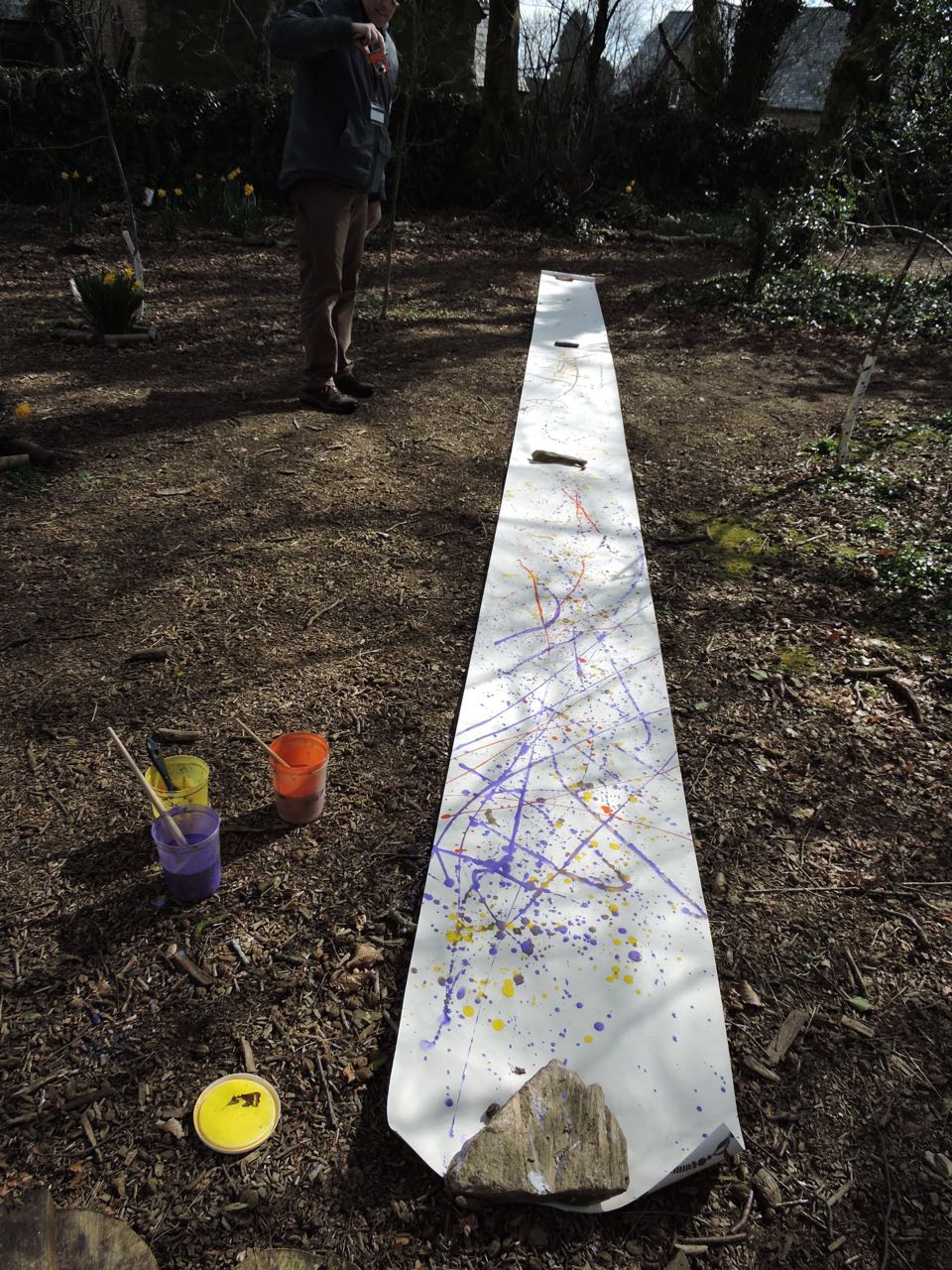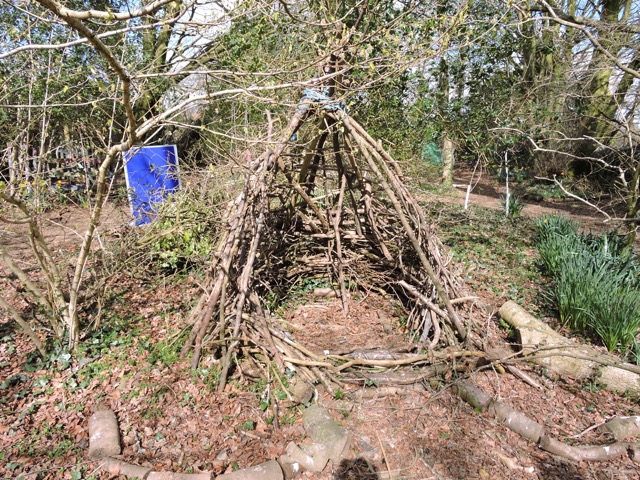Wow what a venue for an opening keynote - the SERTS Theatre at Upton Cross.
A bit TARDIS like inside no shortage of room. Having given my Djembe and N American flute a go at lunch time I found the acoustics to be wonderful.
The first Workshop I attended was by Jenny Nash on PE/Orienteering, below is one of many punches that all have different patterns to prove which control points children have visited.
Another approach is to colour code control points - below is a crayon tied to a bottle that would be tied to something at the control point. Children may well forget to leave the crayon or punch behind if it is not tied down.
Basic map skills, this laminated map shows the marked areas on the ground - see next photo.
Part of the blue square is off camera below. Suggested activities:
Can you line the map up with the marked area? Helps understand use of symbols to represent real world objects and to understand orientation.
Partner stands in the area and map holder has to point to where that is on map. Also works in reverse with one pointing at the map the other going to the spot.
One walks around inside the area while the other follows the trail with their finger on the map.
In a group, but still working in pairs, one of each pair stands with their back to the area so they can not see it, the other places an object in the area, we used identical small balls. Once all objects are in the area those who could not see it have to find which was their partner's object with their partner indicating the place on the map - this reinforces the need for accuracy especially if several objects are close to each other.
Netball numbers - a netball court marked out with objects.
One map of the court - there were 6, each with a different set of cones indicated. The triangle is the start point. The aim is to work in pairs locating and visiting each cone remembering and adding the numbers, the total is then checked with the teacher. There are all sorts of strategies and repeating the exercise with different maps may well lead to them refining their approach - one way is to follow A - B - C... in sequence, it may be faster to look for shortest distances to the next cone or to split up and do half each or...????? Cones are not labelled A B C etc. so control point A on Map 2 might be on one of the semi-circles. Cones could also be off the lines, numbers on the cones could be sums, word puzzles etc.
Cardinal Cones
Cones are set out in a grid, there were 9 in our course, 3 rows of 3 all equally spaced.
Route card, there should be several of these each one with different directions on it.
Each cone has a letter and the cardinal points marked on it - all cones are aligned with cardinal directions - the N indicator is to the north. Children follow the directions on their route card using the cone they are at to work out where to go next. They note each cone letter sequentially in the circles on the route card. Checking the letter sequences lets teacher know whether they have understood the task.
Larger scale orienteering A hand drawn map of the school, there are various ways to achieve this including paying for a proper map to be made. Symbol cards were also used - interpretation of features is important, for example the CP square has a low fence symbol. Control points are marked with circles.
Another map building activity, the map is cut into squares and laminated it is then a jigsaw puzzle the children have to assemble.
I worked with Steve who was over from America visiting Natural Connections schools to take back inspiration to his school. We started off OK only getting a little bit distracted by the on site resources..
...and the chickens.
Then we found a control point on the gate to the forest schools area and had to abandon orienteering temporarily and take a look. First up a very muddy mud kitchen.
Fire circle and tyre swing.
Rainproof den.
Splatter path - no idea about the aim but clearly a work in progress by one of the other workshop groups and rather pretty.
A place to be! So much more adaptable than fit trails and research shows places like this get far more play hours than fit trails.
Another place to do stuff, again some splattery art was underway.
Protected pond, not quite so pretty but a lot safer than an open pond and a great haven for wildlife. Good to have a bridge to look into the water from.
More shelter fun.
A hanging things on it tree reminded me of the many clootie trees found near 'holy wells' and other sacred sites. Also is good to hang up noise making things and make a Singing Ringing Tree.
Graffiti Art?
My favourite productive activity - gardening, well designed raised beds ready for planting lots of compost bins as well mostly out of shot though.
Nice gaming room.
Wonderful stone, cob and timber round house. Living roofs are not easy I hope lots of wild meadow flowers grow as the year progresses. They can be great locations for alpines, hardy succulents, mosses etc.
Wonderful interior I wonder if that was real ox blood wash!
Workshop 2 was natural music from natural things by Chris Holland check out his web site and book lovely chap, great photographer and musician.
I got so engrossed in what we were doing that I forgot to take many photos, we played twigs and stones and leaves and all sorts of stuff. We wandered through the woods noticing things then sang a song each taking turns to add a line about what we had seen.
The photo below is of musical notation each object representing a different sound or movement; claps, body percussion, vocalisation, whatever goes. I found this remarkably difficult. Since 1968 I have been playing a load of instruments I started with bagpipes but that didn't last long then guitar, all sorts of drums, balafon, mbira, saxophone, didgeridoo, and many more. Unfortunately I have never managed to be fluid with notation, I can decode but not well enough to play from it. I think I am better working from memory than images I enjoyed the challenge though and am sure children would enjoy developing and using such codes themselves. We discussed variations - varying the spacing to indicate rhythm, varying placement to indicate pitch, putting several notations next to or above each other to be played together.
Sue Pybus at the Marine Award session, Sue and Matt Nott run an award bearing after school club at the St Nicolas school in Downderry. There is a good video about their work here. We had to sort the things into ones that came from the sea or had ingredients from the sea. There were natural things like salt and samphire, along with cosmetics tooth paste and manufactured food.
More sorting, this time of shells based on morphology.
There were subtle differences within the groups that needed further separation - top shells have their point on top and there are similar looking species that have their point more laterally positioned.
Choosing one shell we had to record as scientist then as artist, I didn't have much time for either as I got talking during the activity but at least my mussel propeller and boat were authentically child like. I went for ratios and found my mussel length (x), width (y) and height (z) were x= 2y y=4z so clearly x=8z no time to check against other shells though. I was about to start measuring growth lines when we had to stop.
Antony Jinman, described by Sue Waite as 'explorer in residence' at Plymouth University, talked us through his trips to the N and S poles. It sounded like he did a great project with daily interaction from the ice with school children via internet. Inspired at an early age by Scott's adventures he aims to plant inspirational seeds in todays children.
Sue closed with some interesting thoughts about spaces and places. Steve from America was keen to see the moors so we headed up to Minions with Sue and her husband, has a quick walk through the Hurlers stone circles then up to the cheesewring and the sun gave us an excellent finale to the day.




































you clearly had a great time - so envious!
ReplyDelete